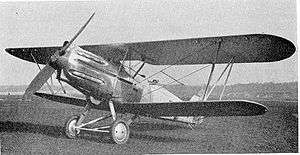Hawker Hector
| Hector | |
|---|---|
 | |
| Role | Army cooperation |
| Manufacturer | Hawker Aircraft |
| First flight | 14 February 1936 |
| Number built | 179 |
| Developed from | Hawker Hart |
The Hawker Hector was a British biplane army co-operation and liaison aircraft of the late 1930s; it served with the Royal Air Force and saw brief combat in the Battle of France in May 1940. Some Hectors were later sold to the Irish Free State. It was named after the Trojan prince Hector.
Design and development
The Hector was intended as a replacement for the Hawker Audax army co-operation aircraft. The design and the building of the prototype was done by Hawkers but production aircraft were built by Westland Aircraft in Yeovil, Somerset. Because of the demand for Rolls-Royce Kestrel engines required for the Hawker Hind programme, an alternative power plant was specified. Consequently, the Napier Dagger III was used. The prototype first flew on 14 February 1936 with George Bulman as pilot. One prototype and 178 production aircraft were built. 13 of these were supplied to Eire in 1941–2.
Operational service
Starting in February 1937, the Hector equipped seven RAF army co-operation squadrons, but began to be replaced by Westland Lysanders from July 1938.[1] The Hectors were transferred to Auxiliary Air Force squadrons; 613 Squadron were in the course of converting to Lysanders at RAF Hawkinge when they flew in support of the Allied garrison in the Siege of Calais. On 26 May, along with the squadron's Lysanders, six Hectors dive bombed German positions around Calais and on the following day, attempted to drop supplies to the troops, unaware that they had already surrendered; two Hectors were lost.[2] Hectors were used by the RAF from 1940 as target-tugs, and for towing the General Aircraft Hotspur training glider.
Irish Air Corps examples were received after the Dunkirk Evacuation. In general they were in poor condition. They were sold by the British War Office to Ireland upon requests for aircraft. The Irish military were wholly unprepared for major warfare, but still relied almost totally on military supplies from Britain. The defence of Ireland was also in the British interest, but with the Battle of Britain raging in the skies, could afford to sell the Irish Government nothing better than the Hector. The type was deeply unpopular with ground crews due to the complicated nature of the engine, which had 24 cylinders, with 24 spark plugs and 48 valves, all of which required frequent maintenance.
Variants
- Hector Mk I : Two-seat army co-operation aircraft for the RAF.
Operators
Specifications (Hector)
Data from Hawker Aircraft since 1920 [4]
General characteristics
- Crew: Two
- Length: 29 ft 9¾ in (9.09 m)
- Wingspan: 36 ft 11½ in (11.26 m)
- Height: 10 ft 5 in (3.18 m)
- Wing area: 346 ft² [5] (33.1 m²)
- Empty weight: 3,389 lb (1,537 kg)
- Loaded weight: 4,910 lb (2,227 kg)
- Powerplant: 1 × Napier Dagger III 24-cylinder air-cooled H-block engine, 805 hp (601 kW)
Performance
- Maximum speed: 162 kn (187 mph, 301 km/h) at 6,560 ft (1,999 m)
- Stall speed: 44 kn (50 mph,[6] 80.5 km/h)
- Range: 261 nmi (300 mi,[5] 483 km)
- Service ceiling: 24,000 ft (7,815 m)
- Wing loading: 14.2 lb/ft² (67.3 kg/m²)
- Power/mass: 0.17 hp/lb (0.27 kW/kg)
- Climb to 10,000 ft (3,050 m): 5 min 40 s
Armament
- Guns:
- 1 × forward-firing .303 in (7.7 mm) Vickers machine gun Mk.V
- 1 × .303 in (7.7 mm) Lewis gun in the rear cockpit on a Hawker mount
- Bombs: Mountings for a camera, flares, and 2 × 112 lb (50 kg) bombs (or containers)
Surviving Aircraft
In the mid-1990s, an ex Irish Air Corps Hector was recovered for restoration near Dundrum in Ireland.[7] Parts of Hector K8096 still lie on Red Pike in the English Lake District. The aircraft crashed here on September 8, 1941, killing its pilot.[8]
See also
- Related development
- Related lists
References
| Wikimedia Commons has media related to Hawker Hector. |
Notes
- ↑ Jackson, Robert (2006), Army Wings: A History of Army Air Observation Flying 1914-1960 Pen & Sword Books Ltd ISBN 978-1844153800 (p. 61)
- ↑ Owen Gordon Thetford, Aircraft of the Royal Air Force since 1918, Putnam, 1962 (p.304)
- ↑ Halley 1980, p. 352.
- ↑ Mason 1991, p.265—266.
- 1 2 Mason 1994, p.281
- ↑ ATA Ferry Pilots Notes 1996
- ↑ Simpson, Andrew (2013). "A/C SERIAL NO.BAPC82 SECTION 2B INDIVIDUAL HISTORY Hawker Hind (Afghan) BAPC 82 MUSEUM ACCESSION NO.69/A/104" (PDF). Royal Air Force Museum. Retrieved 7 August 2015.
- ↑ "Hector K8096 on Red Pike, Wasdale.". Aircraft accidents in the English Lake District. Yorkshire Aircraft. Retrieved 7 August 2015.
Bibliography
- Air Transport Auxiliary Ferry Pilots Notes (reproduction). Elvington, York, UK: Yorkshire Air Museum, 1996. ISBN 0-9512379-8-5.
- Crawford, Alex. Hawker Hart Family. Redbourn, Hertfordshire, UK: Mushroom Model Publications Ltd., 2008. ISBN 83-89450-62-3.
- Halley, James J. The Squadrons of the Royal Air Force. Tonbridge, Kent, UK: Air Britain (Historians), 1980. ISBN 0-85130-083-9.
- Mason, Francis K. Hawker Aircraft since 1920. London: Putnam, 1961 (Third revised Edition 1991). ISBN 0-85177-839-9.
- Mason, Francis K. The British Bomber since 1914. London: Putnam. 1994. ISBN 0-85177-861-5.